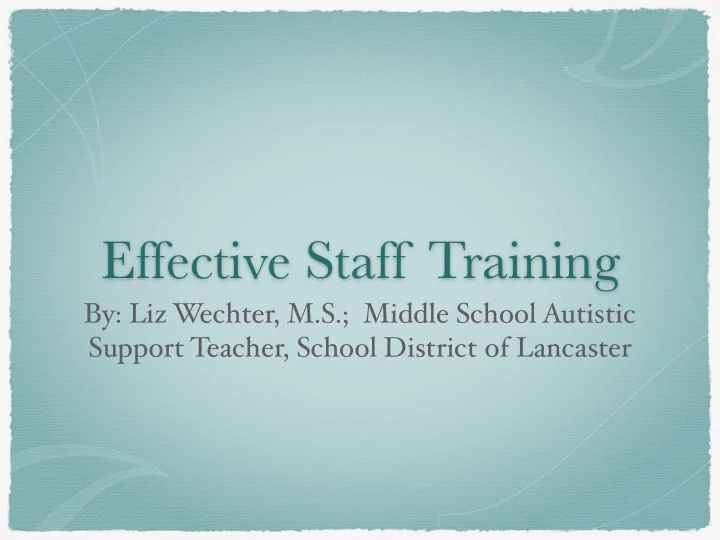

Effective Staff Training By: Liz W echter, M.S.; Middle School Autistic Support Teacher, School District of Lancaster
About Me • SDOL for the past three school years • Y ear one - not a focus at all • Y ear two is when sta ff training started to develop • Y ear three — made sta ff training and the usefulness of training more prominent
Behavior Skills Training Used to teach individuals to implement behavior - analytic techniques
Steps of BST 1. Baseline 2. T raining 3. Rehearsal 4. Modeling 5. Post T raining
1. Baseline sta ff are given specific criteria to follow, usually in written form usually includes a list of definitions of the components for discrete trial teaching told to “do discrete trial teaching the best that you can”
2. Training T rainer goes over the written procedures with trainee step by step T rainer gives copy of trainee’s baseline performance to them Feedback on the baseline scores is given
3. Rehearsal T rainee performs discrete trial teaching while being observed by trainer Immediate descriptive feedback is provided following the performance Positive comments on target steps performed correctly Informative feedback on improvements that are needed
4. Modeling T rainer then performs discrete trial teaching Focus on steps that have been previously been completed incorrectly by trainee Modeling and rehearsal can be practiced multiple times if needed
5. Post- Training T rainer again tells trainee to “do discrete trial teaching the best that they can” T rainer conducts an observation without providing any immediate feedback
How do I effectively train staff? PAIR Provide USEFUL resources Complete fidelity checks Model/Guided Practice Follow up observations Team Meetings
Pair Why do you think it is important to pair with your sta ff ? How would you e ff ectively pair with your sta ff ?
Pair Create positive interactions with sta ff Create open communication W atch them interact with students Compliment the good!
Do’s and Don’ts DO NOT: Immediately correct them try to correct everything at once correct sta ff in the moment every time
DO: Talk to them and treat them like people Compliment the good Figure out how they learn best Modeling, written, guided practice, etc
Provide USEFUL resources Helpful cues around the classroom table cues wall cues specific student cues schedule prompts procedural prompts
Provide USEFUL resources Provide areas and opportunities for sta ff to ask questions Clipboards Mailboxes Area behind my desk
Provide USEFUL resources Operant of Targeted Prompt Used Response Paper resources Echoic Tact Annotated fidelity checks Tact/Textual (sometimes Intraverbal Operant sheets echoic) LRTFFC cheat sheet Physical Prompt Imitation Videos Listener Imitation Response PATTAN video link Easier Echoic/ Other sta ff members Echoic Visual Cue
Complete Fidelity Checks Promise Reinforcer IT Mand ADL Tact parts and features
Complete Fidelity Checks Fidelity check binder Fidelity check chart
Model/ Guided Practice Promise Reinforcer
Model/Guided Practice Promise Reinforcer — sta ff
Model/Guided Practice W alk with Me
Model/Guided Practice “Come here”
Model/ Guided Practice Intensive Teaching
Model/Guided Practice Intensive Teaching
Follow up observations Fidelity check chart Revisit notes or focus from last fidelity check Allows me to see growth Additional support that needs to be provided
Team Meetings Provide general recommendations to group T rain/model in a setting without students Allows you to recap and discuss specific situations Practice skills with immediate feedback
Team Meeting/Training Log
Common Questions How do you get sta ff “buy in”? How do you know this is e ff ective? How do you prioritize what you are going to train on?
How do you get staff “buy in”? PAIR Create open communication Reinforce sta ff successes Point out student successes and growth Provide feedback that will help them grow
How do you know this is effective? Sta ff growth Overall score increase Getting a Y es on something you’ve been working on Quicker implementation of recommendations As intense training is not even Able to recognize what they
MANDING
Intensive Teaching
Intensive Teaching
Intensive Teaching
ADLS
ADLS
How do you know this is effective? Student growth increase acquisition of skills Increase manding skills Decrease problem behavior
SEPTEMBER 2017
JANUARY 2018
MAY 2018
Skill Aquisition
55
How do you know this is effective? Overall classroom growth Site review scores Fall 2015/ Spring 2016: 80 or lower Fall 2016/ Spring 2017: 80 or lower Fall 2017 AND Spring 2018: 95
How do you prioritize what you are going to train on? Student need/ concern Sta ff need/ question Procedural drift observations
Barriers Time Inconsistent sta ff Procedural drift
Questions?
Resources Cooper, J. O., Heron, T. E. and Heward, W. L. (2007). Applied Behavior Analysis, 2cd Edition, Prentice Hall: Upper Saddle River, NJ DiGennaro F .D, Martens B.K, Kleinmann A.E. A comparison of performance feedback procedures on teachers' treatment implementation integrity and students' inappropriate behavior in special education classrooms. Journal of Applied Behavior Analysis. 2007;40:447–461. DiGennaro F .D, Martens B.K, McIntyre L.L. Increasing treatment integrity through negative reinforcement: E ff ects on teacher and student behavior. School Psychology Review. 2005;34:220– 231. Miles I. N, Winder A. D. The e ff ects of behavior skills training on caregiver implementation of guided compliance. Journal of Applied Behavior Analysis. 2009; 42: 405-410 Saroko ff , A. R, Strumey, P . The e ff ects of behavior skills training on sta ff implementation of discrete trial teaching. Journal of Applied Behavior Analysis. 2004; 37: 535-538 Wilder D.A, Atwell J, Wine B. The e ff ects of varying levels of treatment integrity on child compliance during treatment with a three-step prompting procedure. Journal of Applied Behavior Analysis. 2006;39:369–373
Contact information: Email: lawechter@lancaster.k12.pa.us
Recommend
More recommend